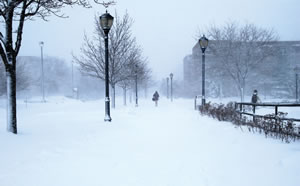Plan A

PHOTO © WELLPHOTO
When the rain started in southern Louisiana on Thursday evening, August 11, no
one was paying much attention. Why would they?
The radar looked clear; no hurricanes in sight, no tropical storms
churning. It was just a little rain, so Kristin Sanders, assistant vice
president for communication at Louisiana State University (LSU)
in Baton Rouge, went to bed as usual.
By morning the situation changed. Heavy rain spurred flash
flooding… and it got worse from there. Over the next few days
seven trillion gallons of water fell. When the storm-with-no-name
was over, 30,000 people were evacuated and 13 lives were lost.
What started as “a little rain” ended up being the nation’s worst
natural disaster since 2012’s superstorm, Hurricane Sandy.
Even though the August event was unexpected, Sanders and the
rest of LSU’s crisis communication team knew what to do. The plan
was activated remotely, allowing team members to work from home.
Events were cancelled and messages were crafted, approved and
sent out. When Sunday brought massive power outages, everyone
assembled in the school’s Emergency Operations Center — a room
in the public safety building — and worked for the next nine days.
Through it all, they relied on their tried-and-true crisis communication
plan. Because of it Sanders knew what to do, what to bring and
even where to sit.
Unfortunately, she’s had a lot of practice. “We’ve had more than
our fair share of opportunities to execute this plan,” recalls Sanders.
She’s not kidding.
Hurricanes and tropical storms may be the norm in Louisiana,
but weather isn’t the only reason a school might activate the plan.
LSU initiated it one month earlier when violence and unrest gripped
the surrounding city. While the conflict never spilled over into the
campus the plan was there, just in case. As a result, operations ran
smoothly and accurate information was disseminated.
And that’s the beauty of a crisis
communication plan. It defines roles,
identifies stakeholders and sets guidelines.
Emergencies take many forms, but
a solid, well-rehearsed plan adapts to the
situation. Would your school be just as
prepared?
What is a Crisis?
There are many reasons a school would
reference their crisis communication plans.
Some are obvious and immediate: think
natural disaster, active shooter or building
collapse. Others are a bit more nuanced, such
as sexual assault incidents or a disgruntled
staff member who might talk to the press.
Others are, in the words of Charles
Dolan, senior vice president, kglobal, “longsimmering.”
He offers some hair-raising
examples: a board that fired and then
rehired a president after staff and student
uproar, a nondenominational school that
took heat after removing a Christian cross
from the campus or the now-retracted 2014
Rolling Stone article about a gang rape at
the University of Virginia.
Clearly the stakes for each situation are
different, yet a comprehensive crisis plan
offers guidance for all. “You could activate
just part of your plan,” explains Sanders.
“Or refer to it for ideas.”
What’s the Plan… and Where Is It?
“A detailed crisis communications plan
will help you evaluate the scope and level of a
crisis while establishing a uniform communications
system, procedures and protocols,”
writes Susan Shelby, president and CEO, Rhino
PR. Having this in place allows a school
to provide, “precise, consistent information”
to the appropriate stakeholders. “You don’t
want to be just figuring these things out on
the fly during an event,” she says.
That information and those stakeholders
will change depending on the situation.
And while you can’t plan for everything, the
document should be flexible enough to cover
a variety of situations. It should also grow
and change over time. “When we first drew
up our plan in 1997 it was a couple of pages
long,” remembers Sanders. “Now it’s a gigantic
binder with many different scenarios.”
While Shelby does not recommend putting
the actual plan in a binder, “It should
be in the cloud, accessible to everyone. A
binder will just end up on a shelf collecting
dust,” Sanders disagrees. “I have three
of them,” she says. “One at the office, one
at home and one in my car. You have to be
prepared if the power goes out.”
I’ll Do the Talking
A good plan identifies every player and his
or her responsibilities as the crisis unfolds. It
should name one spokesperson, “usually the university president,” according to Sanders, who will speak and answer
questions at press conferences. The team, however, will be more expansive
depending on the situation. Members can include campus police,
the dean of students, head of facilities, a purchasing specialist to secure
supplies and someone from IT to tackle computer issues, among others.
Disseminating the messages after a press conference is key, as people
have questions. Is the school open or closed? Where do I go? If the
school is closed what happens to my event or test? “Students and faculty
want to know how an incident will affect them,” explains Sanders.

PHOTO COURTESY OF JOSEPH KRANAK
ARE WE READY FOR THIS? Not every emergency situation on campus will fit the definition
of a “crisis,” but even incidents of severe weather — such as a hurricane, blizzard or
flood — should remind administrators that when anything occurs that disrupts normal
day-to-day operations, the primary criteria for successful communication is preparedness.
A trained communications team should prepare notification to the campus community and
broadcast it to the campus as well as to stakeholders in the surrounding community, which
can include first responders, medical facilities, delivery services and utility companies.
As much as possible, all non-essential personnel should be cleared from campus; those
individuals without alternative plans may be required to report to a predetermined location.
Campus facilities should be prepared and available for students and staff who may be
stranded until the event resolves.
Different channels should be used to disseminate that information.
An emergency text system is not enough. “Not everyone signs up
for it,” she explains. She uses a broadcast email system that can’t be
unsubscribed from, along with posting information on a website and
social media. A big-enough event might warrant its own micro-site.
A crisis that involves your school’s reputation should be handled
differently. Dolan suggests placing two people on social media duty,
monitoring feeds constantly for inaccurate information and addressing
it when it appears — and it will — with approved messages.
“This way you are defining the situation as opposed to someone who
wants a juicy story,” he explains. He also suggests daily reviews of
what’s been said or done and how to adjust your message.
No Comment?
Your institution’s spokesperson will spend a lot of time with the
media during a crisis. Because of this Shelby recommends the individual
go through some professional training, often given by a former
investigative reporter. Here your representative will learn how to calmly
answer questions, convey the correct amount of information and not
get emotional or off track. Training sessions will be videotaped.
Despite the best preparation, a spokesperson can’t know the answer
to every question. “That’s okay,” according to Shelby. “What’s not
okay is guessing. If you don’t know something, it’s acceptable to offer
to find out the answer and get back to the reporter before deadline.”
What if something is too controversial to discuss? Is it ever
okay to say “no comment?” “No,” Shelby insists. “Explain as
much as you can. ‘No comment’ sounds as though you’re hiding
something.”
Grace Under Pressure
Plans need to be reviewed and practiced once or twice a year.
“Communication changes so fast that there might be a new social
media outlet that you haven’t addressed before,” says Dolan.
Sanders, at LSU, agrees. “We have 5,000 employees and 34,000
students. Emergency personnel change. It might feel redundant to
someone like me who’s been at the school for 20 years but it will
always be new to someone.”
And don’t use size to justify avoiding the issue. Incidents happen everywhere.
“Even small schools need a plan,” insists Shelby. Both she and
Dolan suggest building a relationship with a public relations firm that
can either assess a current protocol or step in mid-crisis if needed.
This article originally appeared in the issue of .